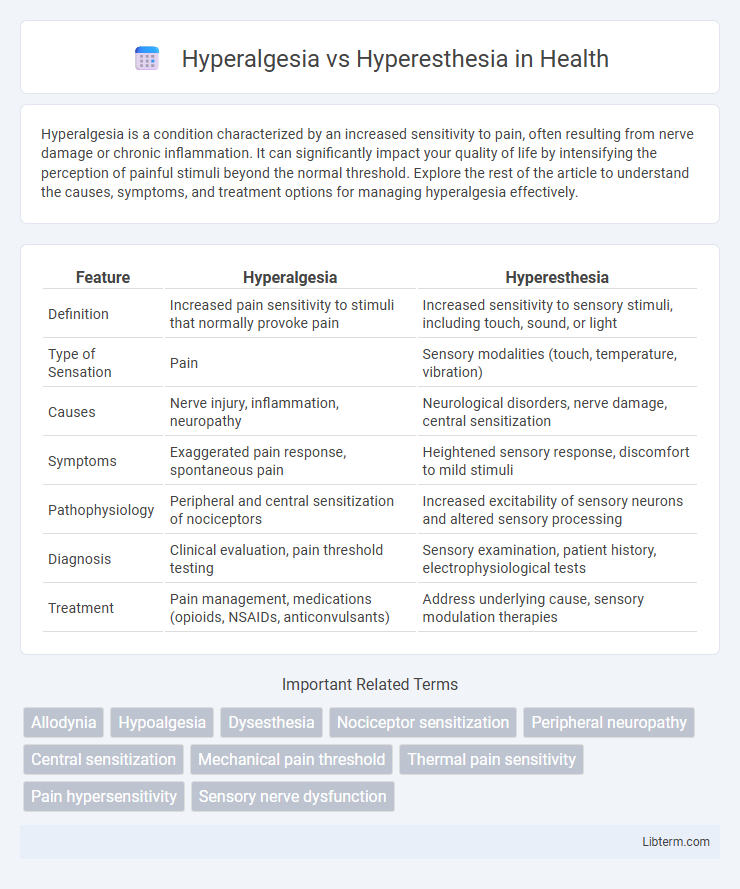Hyperalgesia is a condition characterized by an increased sensitivity to pain, often resulting from nerve damage or chronic inflammation. It can significantly impact your quality of life by intensifying the perception of painful stimuli beyond the normal threshold. Explore the rest of the article to understand the causes, symptoms, and treatment options for managing hyperalgesia effectively.
Table of Comparison
| Feature | Hyperalgesia | Hyperesthesia |
|---|---|---|
| Definition | Increased pain sensitivity to stimuli that normally provoke pain | Increased sensitivity to sensory stimuli, including touch, sound, or light |
| Type of Sensation | Pain | Sensory modalities (touch, temperature, vibration) |
| Causes | Nerve injury, inflammation, neuropathy | Neurological disorders, nerve damage, central sensitization |
| Symptoms | Exaggerated pain response, spontaneous pain | Heightened sensory response, discomfort to mild stimuli |
| Pathophysiology | Peripheral and central sensitization of nociceptors | Increased excitability of sensory neurons and altered sensory processing |
| Diagnosis | Clinical evaluation, pain threshold testing | Sensory examination, patient history, electrophysiological tests |
| Treatment | Pain management, medications (opioids, NSAIDs, anticonvulsants) | Address underlying cause, sensory modulation therapies |
Understanding Hyperalgesia: Definition and Mechanisms
Hyperalgesia is a condition characterized by an increased sensitivity to pain, often resulting from injury, inflammation, or nerve damage that amplifies pain signals through heightened nociceptor activity. This phenomenon involves central sensitization processes in the spinal cord and brain, where repeated painful stimuli enhance neuronal excitability and synaptic transmission efficiency. Hyperalgesia differs from hyperesthesia, which refers to an abnormal increase in sensitivity to stimuli but does not specifically pertain to pain sensation.
What is Hyperesthesia? Key Features and Variations
Hyperesthesia is a neurological condition characterized by an increased sensitivity to sensory stimuli, resulting in exaggerated responses to touch, sound, or other sensory inputs. Key features include heightened tactile perception, discomfort or pain from normally non-painful stimuli, and variations such as cutaneous hyperesthesia affecting the skin or visceral hyperesthesia impacting internal organs. Unlike hyperalgesia, which specifically involves amplified pain sensitivity, hyperesthesia encompasses a broader range of sensory modalities with abnormal sensitivity.
Comparing Hyperalgesia and Hyperesthesia: Core Differences
Hyperalgesia refers to an increased sensitivity to pain caused by damage to nociceptors or peripheral nerves, leading to exaggerated responses to painful stimuli. Hyperesthesia, on the other hand, is a general heightened sensitivity to sensory stimuli, including touch, without necessarily involving pain pathways or nerve damage. The core difference lies in hyperalgesia specifically amplifying pain perception, whereas hyperesthesia involves an amplified response to various sensory inputs beyond pain.
Common Causes of Hyperalgesia
Hyperalgesia, characterized by an increased sensitivity to pain, commonly arises from nerve injury, chronic inflammation, or opioid use, which alters pain processing pathways. In contrast, Hyperesthesia involves an enhanced sensitivity to sensory stimuli, including touch and temperature, often linked to neuropathies or central nervous system disorders. Understanding these distinct mechanisms is crucial for accurate diagnosis and targeted treatment strategies for patients experiencing abnormal sensory responses.
Primary Triggers Behind Hyperesthesia
Hyperesthesia is commonly triggered by nerve damage, inflammation, or sensory nerve dysfunction that causes an increased sensitivity to stimuli. Conditions such as peripheral neuropathy, shingles, or phantom limb syndrome often provoke hyperesthesia by altering normal sensory signal processing. Unlike hyperalgesia, which specifically refers to heightened pain response, hyperesthesia encompasses exaggerated sensitivity to various sensory inputs including touch, sound, or temperature.
Clinical Presentation: Symptoms and Diagnostic Criteria
Hyperalgesia manifests as an increased pain response to stimuli that typically cause pain, characterized by exaggerated tenderness and heightened sensitivity in affected areas. Hyperesthesia involves an abnormal increase in sensitivity to sensory stimuli, encompassing touch, pressure, or temperature, without necessarily producing pain. Diagnosis of hyperalgesia relies on quantitative sensory testing (QST) showing lowered pain thresholds, while hyperesthesia diagnosis involves clinical examination and patient-reported increased sensitivity without signs of nociceptive pain amplification.
Assessment Tools for Detecting Hyperalgesia and Hyperesthesia
Assessment tools for detecting hyperalgesia include quantitative sensory testing (QST), which measures pain thresholds using thermal, mechanical, or electrical stimuli to identify increased pain sensitivity. For hyperesthesia, standardized sensory examination protocols evaluate heightened sensitivity to touch or other stimuli, often involving light touch or vibration tests. Both conditions benefit from patient-reported outcome measures, such as pain rating scales and sensory hypersensitivity questionnaires, to complement objective findings and guide diagnosis.
Management Strategies for Hyperalgesia
Management strategies for hyperalgesia primarily involve pharmacologic interventions such as opioids, nonsteroidal anti-inflammatory drugs (NSAIDs), and anticonvulsants like gabapentin, which target altered pain pathways. Non-pharmacologic approaches include cognitive-behavioral therapy, physical therapy, and nerve stimulation techniques to modulate pain perception. Differentiating hyperalgesia from hyperesthesia ensures tailored treatment, as hyperalgesia indicates an increased pain response, whereas hyperesthesia involves heightened sensitivity without necessarily painful stimuli.
Treatment Approaches for Hyperesthesia
Treatment approaches for hyperesthesia primarily involve addressing the underlying cause and managing symptoms through medications such as anticonvulsants, antidepressants, and topical anesthetics. Physical therapy, desensitization techniques, and nerve blocks can also provide relief by modulating nerve sensitivity and reducing abnormal sensory responses. In cases related to neuropathic conditions, a multidisciplinary approach combining pharmacological and non-pharmacological interventions often yields the best outcomes.
Prognosis and Long-Term Outlook for Affected Patients
Hyperalgesia typically presents with an increased pain response to stimuli that are normally painful, often linked to chronic conditions like neuropathy or opioid use, which may lead to persistent discomfort requiring long-term management strategies. Hyperesthesia involves heightened sensitivity to sensory inputs, including touch and temperature, and its prognosis varies depending on underlying causes such as nerve injury or systemic diseases, with potential for improvement as the primary condition is treated. Both conditions can significantly impact quality of life, but early intervention and targeted therapies improve long-term outcomes by addressing the root pathology and mitigating symptom progression.
Hyperalgesia Infographic

 libterm.com
libterm.com